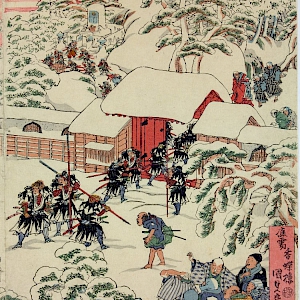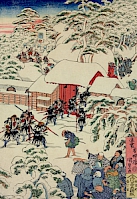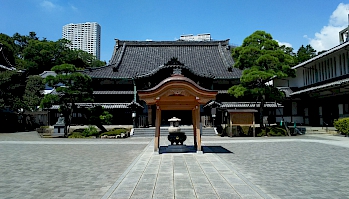Temple as a Scholarship and Cultural Platform: Sengakuji and Zen in Japanese Culture

In Japan, temples have played a crucial role in people’s lives for a long time. Having a close linkage with urban areas, temples may be compared to ‘windows’ navigating us through the historical and cultural layers of an urban city. Temples reveal the story of urban societies which have been handed down from the past to the present.
Sengakuji was founded by Tokugawa Ieyasu, the first shogunate of the Edo period, in 1612, and has functioned as a scholarship and cultural platform of Zen Buddhism. It was acknowledged as one of the Edo’s three main
gakuryō (Buddhist Colleges) which belongs to the ‘Sōtō-shū sect’ alongside Kichijōji Sendanrin in Komagome and Seishōji Shishikutsu in Shiba-Atago.
Set in Sengakuji, this program will explore the development of Japanese culture and Zen. The program consists of two sections, a guided tour and a lecture, both focusing on the history of gakuryō, Japanese literature and fine arts of Zen, and the important roles that Sengakuji and other Zen temples have played in the cultural history of Japan.
* The lecture will be held in Japanese. However, we will provide English language support for non-Japanese speakers.
Date
Sunday 18 November 2018, 10:00-11:30/13:00-14:30
Venue
Sengakuji temple
Audience
This event is open to everyone. Pre-registration is required.
Guided tour: Max 35 seats (by lottery) / Lecture: Max 40 seats (by lottery)
(People who live, work or studies in Minato city have priorities to join the guided tour).
Date
Sunday 18 November 2018, 10:00-11:30/13:00-14:30
Venue
Sengakuji Temple (2-11-1, Takanawa, Minato-ku, Tokyo, 108-0074)
Audience
This event is open to everyone. Pre-registration is required.
Guided tour: Max 35 seats (by lottery) / Lecture: Max 40 seats (by lottery)
(People who live, work or studies in Minato city have priorities to join the guided tour).
Cost
Free
Booking
Pre-registration is required. If you wish to participate, please fill in this form by Friday 9 November 2018.
We closed the pre-registration. Thank you for lots of applications.
Lecturer/Performer
Kenmyou Muta (Priest/Department Director)
Takashi Horikawa (Professor at the Institute of Oriental Classics [Shido Bunko], Keio University)
Timetable
10:00-11:30 ・Guided Tour “Explore the Precincts of Sengakuji: Its History and Culture”
Lecturer: Kenmyou Muta (Priest/Department Director)/Language: Japanese only
13:00-14:30 Lecture “Scholarship and Culture of Zen Temples”
Lecturer: Takashi Horikawa (Professor at the Institute of Oriental Classics [Shido Bunko], Keio University), Kenmyou Muta
Language: Japanese with language support in English
Enquiries and bookings
Keio University Art Center (Homma, Shino)
2-15-45, Mita, Minato-ku, Tokyo, 108-8345 Tel: 03-5427-1621
pj.ca.oiek.c-tra@yranuc
Organiser(s)
Organiser: Keio University Art Center
Supported by FY2018 Minato Cooperation Project for Cultural Program and the Agency for Cultural Affairs, Government of Japan
Image left: Woodblock print, triptych. Scene from the story of the 47 ronin (Chushingura). 1906,1220,0.1107.1-3, AN437932001, British Museum
Sengakuji
Sengakuji was first founded in the Soto-Sakurada area (near Edo Castle) by Tokugawa Ieyasu in 1612. However, this temple was burnt down by the great fire of Kanei in 1641, and later it was rebuilt at its present location in Takanawa, by the Daimyos starting the Asano family in the “Akō” clan. This is why Sengakuji is regarded as a temple closely related to Akō-Gishi—Gi means ‘justice’ and Shi means ‘samurai’—and their bodies were buried at the temple’s grave.
On the other hand, until the end of the Edo period, Sengakuji was acknowledged as one of the Edo’s three main gakuryō (Buddhist College) as well as Sōrin (temples under the protection and control of the Gozan-Jissetsu-Shozan system) which belongs to the Sōtō-shū sect, and nearly 200 scholar-priests deepened their practice and study in Zen Buddhism.
In the year 1945 (May, Showa 20), most of the temple buildings were burnt down by an air raid during the ravages of World War Ⅱ, however, the grave (where gishi were buried) was safe and have been preserved from the time when they were buried in Genroku era (1688–1704).
http://www.sengakuji.or.jp/about_sengakuji_en/
Gakuryō Public Lectures
Regarded as a temple with its graveyard of Akō-Gishi, Sengakuji has also functioned as a training facility for priests. Acknowledged as one of the Edo’s three main gakuryō along with Kichijōji Sendanrin in Komagome and Seishōji Shishikutsu in Shiba-Atago, scholar-priests gathered from all over Japan and studied Buddhist scriptures, Chinese classics, and Soroku (sutras described by masters).
After the Meiji period, gakuryō—with other schools called gakurin—were merged and reorganized in the form of a modern college, current Komazawa University.
Then, in 2004 (April, Heisei 16), the former Gishi-kan (Akō-Gishi’s hall) was renovated into a lecture hall and have been delivering lectures about Buddhist scriptures, Chinese classics, and Soroku following the traditions, conventionally taught at gakuryō. These lectures are open to the general public aimed at deepening people’s understanding of Zen Buddhism.
Akō-Gishi Festival
The Akō-Gishi Festival takes place annually, in spring and winter.
Every spring, the festival is held from April 1st through 7th to honour Asano Takumi-no-Kami (Feudal Lord of Akō) and the Akō-Gishi loyal retainers who committed seppuku (ritual suicide) for assaulting a court official named Kira Yoshinaka. In the morning, they hold a service for the souls of the lord and the faithful retainers. Then, in the afternoon, they exhibit their temple's treasures at the main hall followed by holding a special exposition of “Marishi-Sonten (hidden Buddhist statues of the Goddess of Wealth and Warrior Class)” of Ōishi Yoshio (the loyal vassal, also known as Ōishi Kuranosuke) and showing the calligraphies written by the prominent samurai Saigō Takamori as well as “Bakumatsu no Sanshu—literally, Three Ships during the end of the Edo period” collective, consists of three men, Katsu Kaishū, Takahashi Deishū, and Yamaoka Tesshū, who have-shū (ship) in their names.
Every winter, the festival is held on December 14th, the day of the raid made by the Akō-Gishi loyal retainers. Celebrating the realization of their long-cherished desire, Sengakuji holds a memorial service in the graveyard, a tea offering ceremony, and a Gishi-Gyōretsu procession. The festival attracts thousands of visitors together with the rows of stalls (70 stalls, approx.) called “Demise” set up inside and outside of the ground of the temple.
Institute of Oriental Classics (Shido Bunko), Keio University
The precursor of the Institute was first founded in Fukuoka in 1938 by Aso Takakichi, president of Aso Trading (now Aso Group), one of the leading coal mining companies operating in the Kyūshū area located in the southern part of Japan, with the purpose of studying the cultural traditions of Japan and Asia. Then, after some preparation, the Institute reopened in 1960, “to collect, preserve, and research materials on pre-modern Japan and Asia.” The Institute now has holdings in excess of 170,000 items, and in 2010, they had an exhibition of their collection and published a catalogue named “Zusetsu Shoshigaku: Kotenseki o Manabu” (Bibliography by Illustrations: Introduction to Classical Books, published by Bensei Shuppan) to coincide with the 50th anniversary of their reopening.
Besides, the Institute holds an exhibition every year to show their extraordinary collection of rare books—kept in the Institute as well as the Keio University Library—and other valuable materials (e.g., old writings and artworks) which were consigned by the Century Cultural Foundation.
http://www.sido.keio.ac.jp/en/

